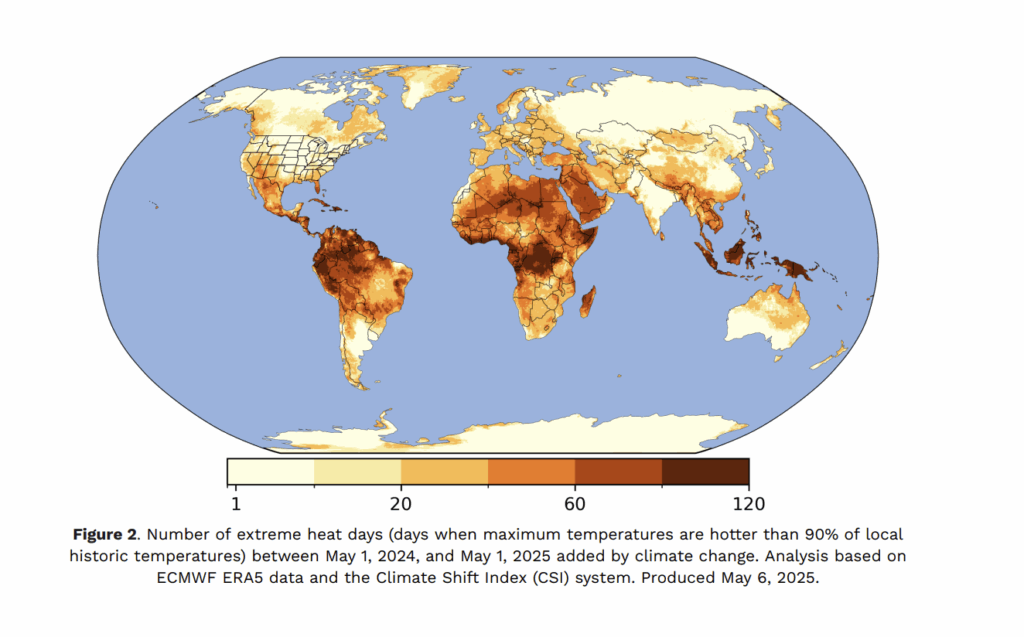Sixty-seven extreme heat events have occurred since May 2024. All of these events—including a deadly Mediterranean heat wave in July 2024, an unprecedented March 2025 heat wave in central Asia, and extreme heat in South Sudan in February 2025—broke temperature records, caused major harm to people or property, or did both.
According to a new analysis, each of these extreme events was made more likely by climate change. The number of days with extreme heat is now at least double what it would have been without climate change in 195 countries and territories. Climate change added at least an extra month of extreme heat in the past year for 4 billion people—half the world’s population.
“The numbers are staggering.”
“There’s really no corner of the globe that has been untouched by climate-driven extreme heat,” said Kristina Dahl, a climate researcher at the climate change research and communication nonprofit Climate Central who was part of the report team. “Half the world’s population is experiencing an extra month of extreme heat. The numbers are staggering.”
The authors of the report say it serves as a stark reminder of the dangers of climate change and the urgent need for better early-warning systems, heat action plans, and long-term planning for heat events across the globe.
The report was created by scientists at Climate Central; World Weather Attribution, a climate research group; and the Red Cross Climate Centre.
More Frequent Heat
In the new report, scientists calculated the number of days between 1 May 2024 and 1 May 2025 in which temperatures in a country or territory were above 90% of the historical temperatures from 1991 to 2020. Then, they analyzed how many of these extreme heat days were made more likely by climate change using the climate shift index, a methodology developed by Climate Central that compares actual temperatures to a simulated world without human-caused climate change.
The team found that climate change made extreme heat events more likely in every country.
Over all the countries and territories, climate change added the greatest number of extreme heat days to the Federated States of Micronesia (157 days), and Aruba had the most extreme heat days in total over the past year, 187 days. The report’s authors estimate that in a world without climate change, Aruba would have experienced just 45 days of extreme heat.
Other Caribbean and Oceanic islands were among the countries and territories most strongly affected by climate change. People in the United States experienced 46 days of extreme heat, 24 of which were added by climate change.

Of the 67 extreme heat events that occurred in the past year, the one most influenced by climate change was a heat wave that struck Pacific islands in May 2024. Researchers estimated the event was made at least 69 times more likely by climate change.
The findings are not a surprise to Nick Leach, a climate scientist at the University of Oxford who was not involved in the report. “We’ve understood the impact of climate change on temperature and extreme heat for quite some time…[including] how it’s increasing the frequency and intensity of extreme heat,” he said. Research has consistently shown that heat events on Earth are made more likely, more intense, and longer lasting as a result of climate change.
“Only comprehensive mitigation, through phasing out fossil fuels, will limit the severity of future heat-related harms.”
Leach said the new report gives a good overview of how climate change is influencing heat waves worldwide. However, defining extreme heat as temperatures above the 1991–2020 90th percentile creates a relatively broad analysis, he said. Studies using a more extreme definition of extreme heat may be more relevant to the impacts of extreme heat, and studies estimating those impacts are typically more policy relevant, he said.
The report’s authors chose the 90% threshold because heat-related illness and mortality begin to increase at those temperatures, Dahl said.
Taking Action on Heat Waves
For rising global temperatures, “the causes are well known,” the report’s authors wrote. Burning of fossil fuels such as coal, oil, and gas has released enough greenhouse gases to warm the planet by 1.3°C (2.34°F; calculated as a 5-year average); 2024 marked the first year with average global temperatures exceeding 1.5°C (2.7°F) above preindustrial temperatures.
“Only comprehensive mitigation, through phasing out fossil fuels, will limit the severity of future heat-related harms,” the authors wrote.
Extreme heat puts strain on the human body as it tries to cool itself. This strain can worsen chronic conditions such as cardiovascular problems, mental health problems, and diabetes and can cause heat exhaustion and heat stroke, which can be deadly. Extreme heat is particularly dangerous for already-vulnerable populations, including those with preexisting health conditions, low-income populations lacking access to cool shelter, and outdoor workers.
Heat Action Day on 2 June, hosted by the International Federation of Red Cross and Red Crescent Societies, raises awareness of heat risks across the globe. This year, the day of action will focus on how to recognize signs of heat exhaustion and heat stroke. Dahl recommends using the Centers for Disease Control and Prevention tips on heat and health to stay safe. “Most heat-related illness and death is preventable,” she said.
—Grace van Deelen (@gvd.bsky.social), Staff Writer
Correction, 3 July 2025: This article was updated to give the correct number of extreme heat days added by climate change in the Federated States of Micronesia.

